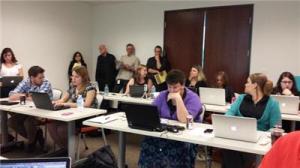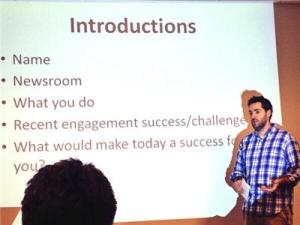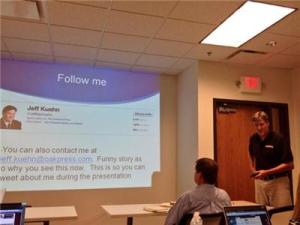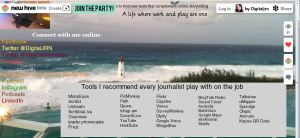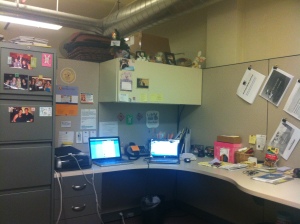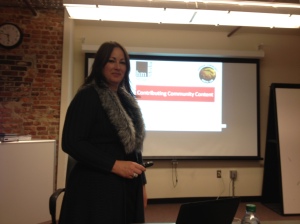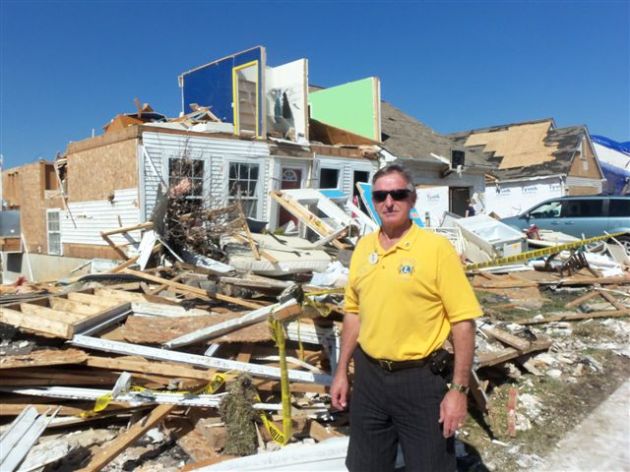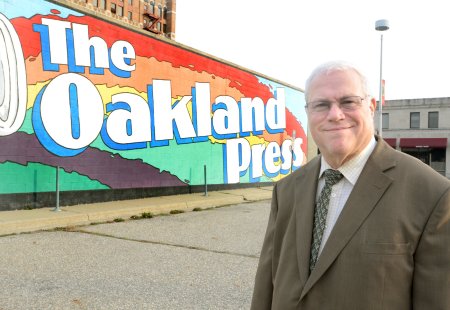
Glenn Gilbert, executive editor of The Oakland Press in Pontiac, Mich., and group editor for 21st Century Media’s Michigan Cluster, is retiring Jan. 3, 2014, after 45 years in journalism. (Photo by Tim Thompson/Oakland Press)
Glenn Gilbert, known for transforming 21st Century Media’s Michigan newsrooms into data- and visually-driven 24/7 content producers that welcome community contributions and engage their audience through two-way conversations and outreach, is wrapping up a 45-year career in a field that has undergone major changes in news gathering and delivery.
“I believe Glenn Gilbert’s legacy will be guiding the newsroom at The Oakland Press, as well as the newsrooms throughout Michigan, through a difficult period of transition – both it was an instable time in the industry, as well as the economy,” said Stephen Frye, online editor at The Oakland Press, “and, also, journalism in general changing with the new digital tools available and the digital outlets.”
In the last seven years, Gilbert, 63, has reimagined newsroom positions – from old-school reporter and copy editor jobs to community engagement editors and multimedia journalists who interact with their audience and use a variety of storytelling methods to convey their journalism through videography, photography, audiocasts, data visualizations, and live-tweeting and blogging.
Just as importantly, he has opened the newsroom to the public, launched community liaison boards, established a blogger network and encouraged media labs to train the audience in covering secondary news and use of digital storytelling tools.
“He had the vision, I believe, to open up the newsroom to the public,” Frye said. “That was the strongest first act that opened people’s eyes in our newsroom when he said, ‘We have to invite the public in to participate.’
“This was in 2007 that he said that – that the readers are part of the storytelling. We rely on them to give us stories, to give us ideas, but also to share their stories, whether that be in blogs or submitted works – (and) for every reporter to work with members of the public.”

Glenn Gilbert is known as the “architect of the modern newsroom” for 21st Century Media’s Michigan Group, which includes The Oakland Press, The Macomb Daily, Daily Tribune in Royal Oak, The Morning Sun in Mount Pleasant, The News-Herald Downriver and Heritage.com.
Frye said reporters, at the time, were witnessing the rise of social networks – and joining the ranks of users – opening up another medium for public expression and storytelling beyond newspapers. It didn’t take long, he said, for Michigan editorial staff to embrace Gilbert’s philosophy of an open, more collaborative newsroom sharing news in real time.
“It was realizing we’re the professionals, but guide those who want to participate,” Frye said.
“It was very quickly that people in our newsroom realized that the readers were part of the future of storytelling.”
Julie Jacobson-Hines, local news editor at The Oakland Press, respects Gilbert for his efforts early on to embrace the change ushered in with the Fifth Estate’s rise, and work to transform 21st Century Media’s Michigan newsrooms.
“I think he has set us up for success in the digital world and social media. Obviously, that’s where the business is going,” Jacobson-Hines said.
“As a newsman, I think he wanted to give more power to the reporters and people in the community to be able to come up with stories rather than us dictating to people what we think the stories should be,” she said.
“He, one time, said he wanted to return the paper to the people, and that’s how it began in the United States. And this, I feel, is his legacy.”
Jeff Kuehn, regional sports editor for 21st Century Media’s Michigan cluster, has worked with Gilbert for seven years, since their days at The Macomb Daily. He has been impressed with Gilbert’s early push, as readers embraced online news sites and social media, to transform traditional newsrooms into 24/7 operations that use social media for crowdsourcing, engaging the public in conversations and sharing news as it breaks.
“He has changed the mindset, not only of us (at The Oakland Press), but he has gone to the weeklies and said, ‘You know, you no longer are a weekly. You should be thinking 24/7. You should be getting your copy up immediately,’” Kuehn said. “He has told dailies, ‘You are no longer a daily. You are a what’s-going-on-now operation.’
“And that has been embraced by some more than others, or I should say some have been quicker to the table than others.”
Transforming weekly and daily newspapers into 24/7 news operations online while maintaining excellence in print – as demonstrated with Local Media Association bestowing its Best Digital and Print Combination award to The Oakland Press in 2013 – is not an easy task, especially with shrinking newsroom budgets resulting from lost advertising revenue as more competition crops up for ad dollars and some businesses are slower to embrace online.
Gilbert, through his position as executive editor, has had to make painful cuts to editorial staff positions, while alleviating some of the hemorrhaging by creating efficiencies with a universal copy editing desk and centralized pagination center serving all of Michigan, with plans to bring in the Midwest sister publications.
“He has had to make some tough decisions because, of course in our business, we’ve had to have some cost-cutting measures, and he has gone into all of those very thoughtfully and thinking each thing through thoroughly,” Jacobson-Hines said. “He has never taken this lightly, but it’s just something that had to be done to keep the doors open of the properties we currently have. It took a lot of guts, I think.”
Despite cuts to editorial staff positions, Kuehn says the Michigan cluster has maintained its editorial integrity and reputation for solid journalism. The cluster continues to earn state and national awards for its journalism. In fact, Kuehn says the group, under Gilbert’s watch, has been a leader on many fronts across the chain, from use of Tout for short-form social-sharing-enabled video, to its macrolocal website Michigan PrepZone, named Top 10 Website distinction in 2013 by Associated Press Sports Editors, featuring high school sports coverage written by staff and community contributors.
“Under trying times, he has done a fabulous job,” Kuehn said. “The Oakland Press, I think … we’re a leader … in the company as far as what we do digitally and maintaining our print product.”
Keeping up with the media
While a student at the University of Michigan, Gilbert learned early on the importance of embracing change to keep up with innovation and efficiencies in industry. In particular, he recalls a conversation with one of his professors.
“I said to the professor … ‘How do you avoid getting stuck into what you’re doing so that you’re blind to what is new?’ And I’ll never forget his answer, although I didn’t understand it at the time … He said, ‘Keep up with the media.’”
But, as Gilbert’s career has been winding down while technology has been racing at a breakneck speed – and after a health scare this past summer – he began thinking more about retirement.
“As I grew older, that comment kept coming back at me – that you had to keep up. And, in my case, it has become increasingly difficult, frankly, and certainly is a contributing factor to the retirement,” he said.
Gilbert is proud of his social media presence since joining the Twitterverse in 2010. He had 4,552 followers and 17,161 tweets as of Dec. 21, according to Muck Rack. He took to Twitter quickly, he said, because he saw the value of it as a tool to steer audience to content.
“Twitter is simple yet difficult to comprehend, but I’ve tried to keep up with Twitter,” he said.
“And, so, it’s a matter of keeping up with the media and turning over the operation to those who know it better than I.”
The philosophy of “turning over the operation to those who know it,” or empowering your digital staff, was first shared by Digital First Media CEO John Paton, as Gilbert recalls.
“I think, honestly, the best decision I ever made was to follow John Paton’s advice. And he was somewhat criticized for the way he put it. He said that the guys with – I think he said, the guys with – the white hair aren’t going to get you where you need to go. Well, I have white hair.
“What he was saying was empower your digital leaders and then get out of their way. And I think that’s what I’ve tried to do. And I think that has brought us great accolades.”
The making of a newsman
Gilbert started his career in 1968 as a high school senior and worked steadily in the field through college before earning his degree, bypassing the traditional stint at the college newspaper. With 45 years in journalism, it’s no surprise that he has had to navigate change.
CLICK HERE TO CHECK OUT A TIMELINE OF HIS CAREER ON DIPITY.
Gilbert’s first job was as in 1968 as a student columnist at News-Herald Newspapers in Southgate for $1 an hour. He was a reporter, and then an editor, at The News-Herald’s Flat Rock Guardian, through 1972, a big responsibility for a student maintaining a full course load and still developing his reporting chops.
After graduating from the University of Michigan with a bachelor’s degree in journalism in 1972, Gilbert was hired as a reporter by The Ann Arbor News. He also worked as an assistant city editor and editorial page editor before departing in spring 1983 with a master’s degree in social sciences under his belt from Eastern Michigan University.
Gilbert had a short stint at The Daily Herald in Arlington Heights, Ill., serving as assistant city editor of the privately held suburban daily from September 1991 to January 1992. He landed at The Beacon-News in Aurora, Ill., for the next eight years, working as city editor, and in February 1992, he took a job with The News-Herald in Willoughby, Ohio, as assistant managing editor. In the Buckeye State, Gilbert was recognized for his leadership abilities and was promoted to managing editor in 1994. Five years later, he was named executive editor.
The Journal Register Co.-owned publication, now part of 21st Century Media, managed by Digital First Media, allowed him more advancement opportunities across its chain, as he accepted a new position as executive editor of The Macomb Daily in Michigan spring 2006. Three months later, he arrived at his permanent home in Pontiac at sister publication The Oakland Press, where he was promoted to group editor of all 21st Century Media nameplates in the Great Lakes State and regional editor for the Midwest, including publications in Ohio and Minnesota.
A hankering for politics
While Gilbert’s long and storied career has been a dream realized for him, it’s not his only aspiration. Since he was in junior high, Gilbert has desired a career in politics. In fact, he decided on a career in journalism because, based on his research in the 1960s, it was where many politicians had their start, in addition to jobs as teachers or lawyers.
“I think I was in junior high when I wrote my first piece for the school newspaper … so that’s what got my taste for it (journalism),” Gilbert said.
“And I ran for student council president in junior high and I was elected.”
Gilbert signed up to work on the high school newspaper as a junior and ran for class president, and succeeded in both endeavors, again marrying both of his passions – journalism and politics.
Throughout his career, Gilbert has stayed actively involved and held close to his journalism roots while also keeping a close eye on politics and public policy.
“If you are covering a City Council meeting, you can experience the politics. You can vicariously,” he said.
“You put yourself in that position. You hear about the problems they solve and deal with, and later as an editorial writer and so forth you are dealing with public policy issues.”
Jacobson-Hines said Gilbert’s nose for news and reputation as a respected newsroom leader precede him.
“People think he is a good newsman,” she said. “In addition to everything else he has done, every week he writes a column about a current topic and it’s usually very well-researched. And he is extremely well-read, as far as he gets his news from a variety of sources.
“No one could second-guess his news judgment.”
The next chapter
With his official retirement day, set for Jan. 3, 2014, fast approaching, many of his colleagues are wondering what the future will hold. Will this visionary and change agent – the “architect of the modern newsroom” at 21st Century Media’s Michigan cluster – ride off into the sunset or will we see him reinvent himself and realize his childhood dream?
Gilbert said in addition to possibly maintaining his blog, “Between Extremes,” tweeting Oakland County news and continuing with his job teaching mass communication at Rochester College, where he has worked for four years, he may finally pursue the path he has been called to since his adolescence.
“That’s the one thing that I thought would be a possibility if I could run for say the state legislature,” he said. “My motive, frankly, would be to tell people the truth, which means … I don’t think I’d attract lobbyists’ support. That just makes it harder to win.”
The West Bloomfield resident – married to Linda, a part-time teacher, and a father of three adult children – isn’t interested in local politics. He said city council and planning commission positions are difficult when dealing with contentious neighborhood issues. He says, however, that he respects and admires those who are willing to take the heat.
One question remains, however. Will he run as a Republican or Democrat? Gilbert said he has always leaned Republican, but with the party’s opposition to the Patient Protection and Affordable Care Act of 2010, he’s not quite sure anymore if he fully identifies with the right wing.
“I don’t know how to characterize myself …,” he says now.
Whatever Gilbert’s future may hold, Kuehn says his boss has at least one advantage. While some of his colleagues have been unceremoniously ushered out of the business, Gilbert has come to a decision on his own.
“He is very fortunate to go out on his own terms,” Kuehn said.
Adds Jeff Payne, editor of The Macomb Daily, “I think his combination of experience, wisdom, insight and tenacity are going to be missed. And whoever is put into that role – You know, I would trust in the people making that decision that they will find someone who is well qualified and will do a great job, but that person is not going to be Glenn.”
Editor’s Note: The writer of this story, Michelle Rogers, is director of community engagement and editorial training for 21st Century Media’s Michigan Group, and Glenn Gilbert is her direct supervisor.
PARTING THOUGHTS
Best Decision: Followed Digital First Media CEO John Paton’s advice to empower the staff’s digital leaders, and then get out of their way.
Worst Decision: Fought the management at The Ann Arbor News, when he was employed there. He said it cost him from a career perspective. As a manager, he has tried to represent the employees’ views to upper management.
Best Gamble: Hiring Aftab Borka, a broadcaster, to assist The Oakland Press with an online video-based news show, called “News at Noon,” that grew into a short-lived partnership with Detroit TV station WADL and now a partnership with public access television. “It was an unconventional hire and I think it has worked out,” he said.
Advice for Staff: Ask yourself where you want to be five years from now and keep that question in the forefront.
Accolades: Best Digital and Print Combination, Local Media Association, The Oakland Press, 2013; Oakland Press named one of 10 newspapers in the country that “do it right” by Editor & Publisher, 2010: Second place, General Excellence, Associated Press, News-Herald, Ohio, 2006; Best of Ohio, Cleveland Press Club, The News-Herald, Ohio, 2005; Distinguished Community Service Award, Lakeland Community College, The News-Herald, Ohio, 2004; Society of Professional Journalists, General Excellence, News-Herald, Ohio, 1999.





